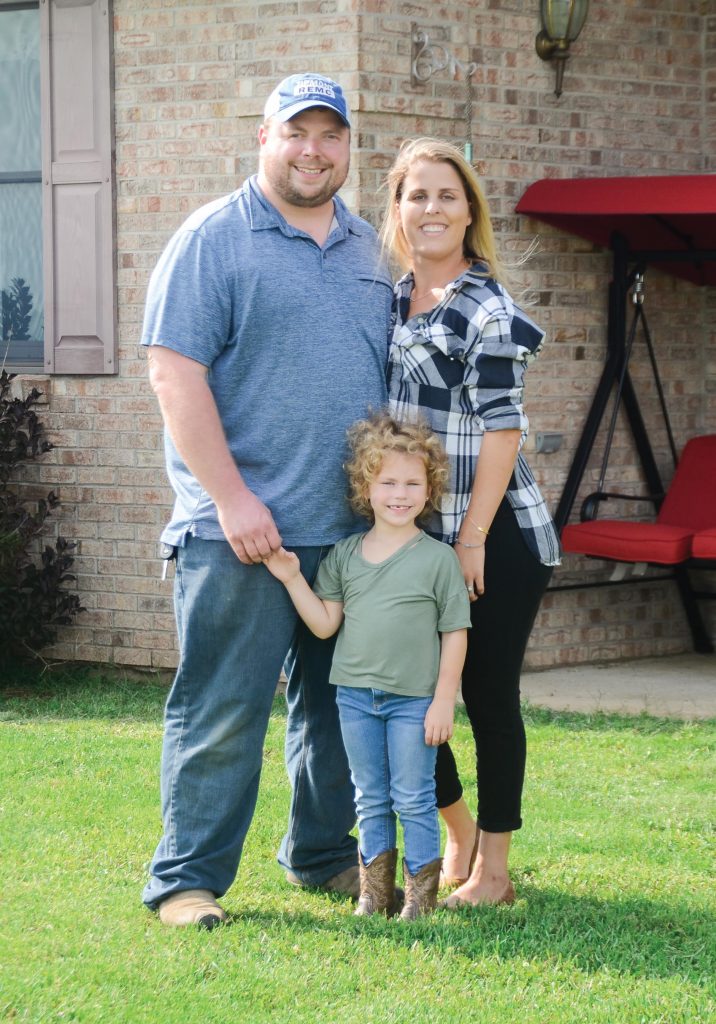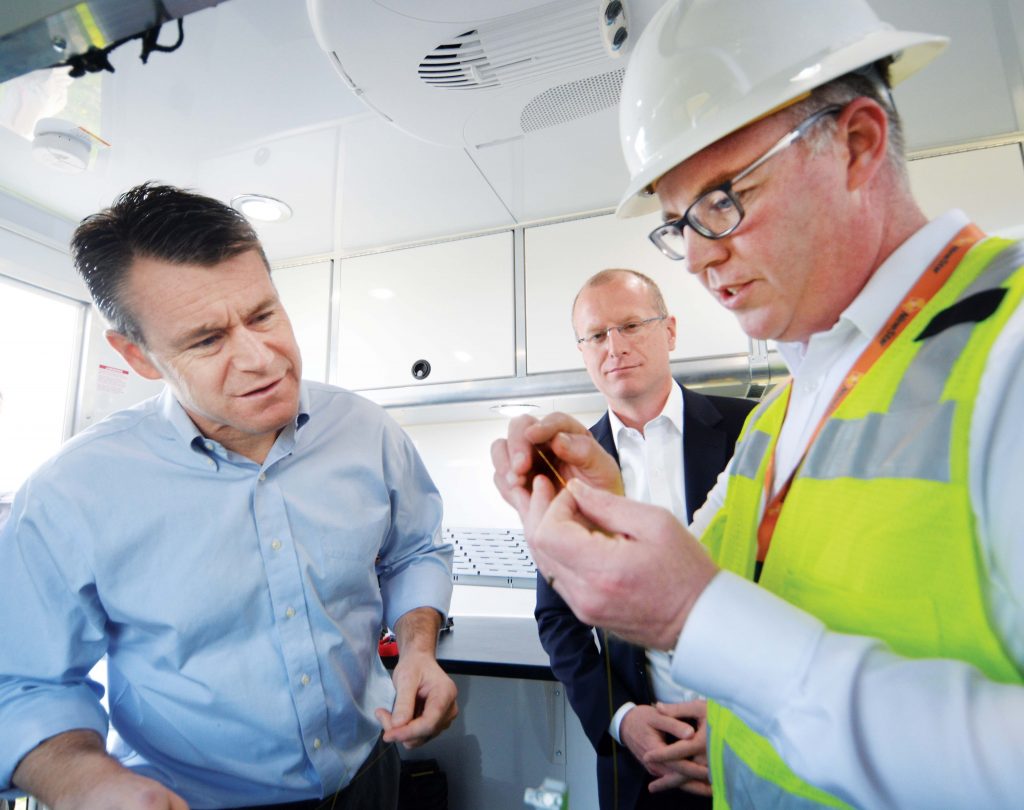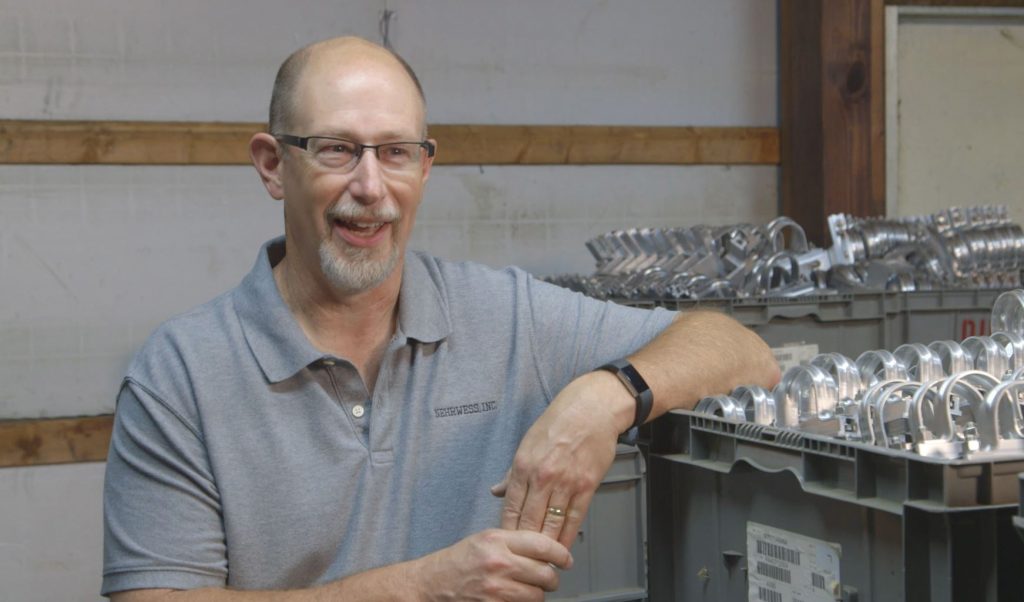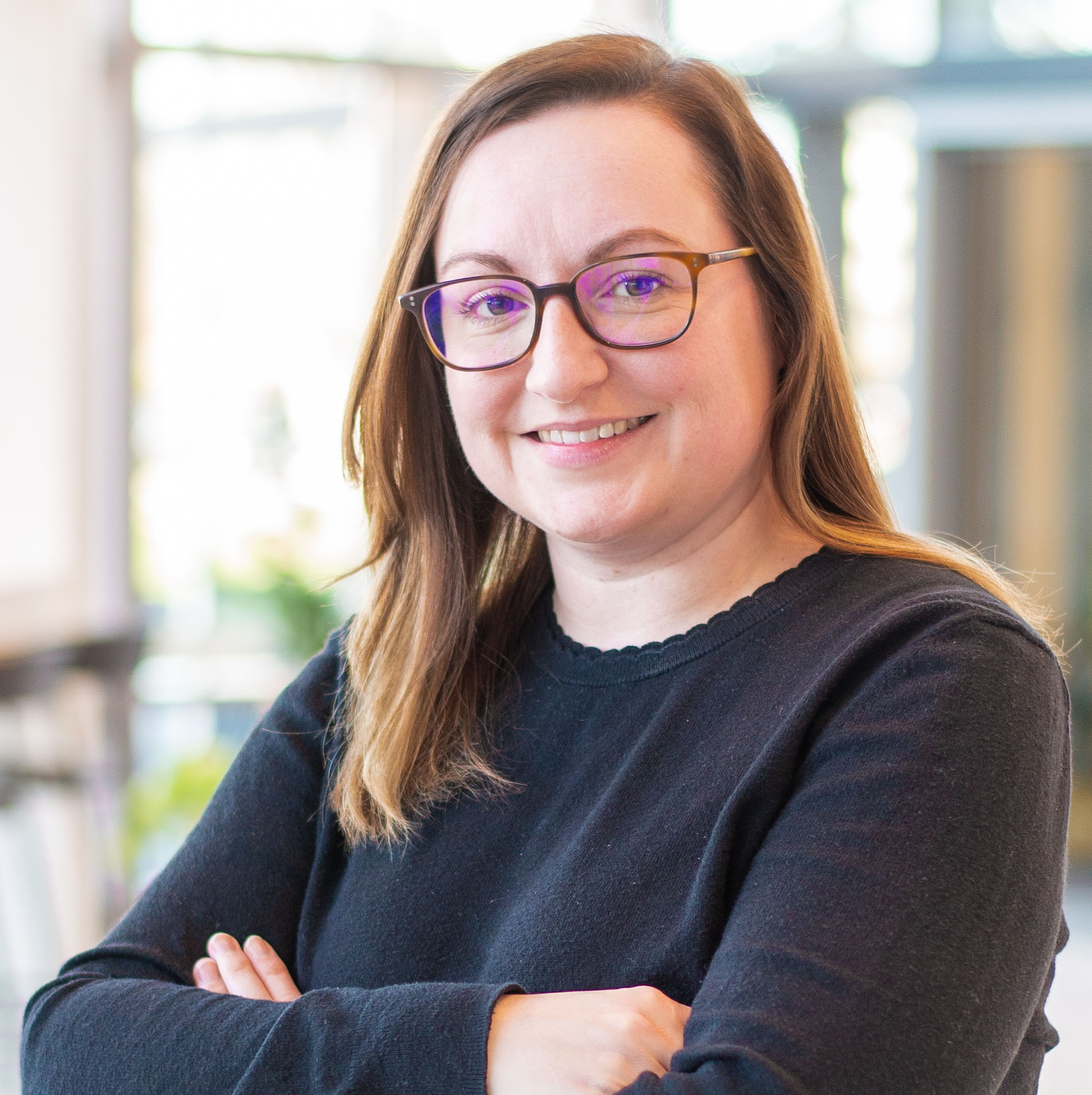
Four years ago, the world stopped turning for Clayton Wilson. While fighting a virus, the Martinsville sixth grader inexplicably suffered something akin to an anaphylactic shock. He required emergency room treatment.
He then began experiencing a series of severe ailments: aches and pains, anxiety, brain fog, fatigue, and even loss of consciousness. The ailments forced him to be bedridden most of the day.
Until then, Clayton had been a normal kid who played soccer and basketball. He had a regular group of buddies and was an “A” student. As his illness wore on without answers from over a half dozen medical specialists, he had to withdraw from school. Then he withdrew from life.
“I just kind of vanished,” he said recently. “I just didn’t want to deal with having to tell people.”
He didn’t feel like having visitors. He didn’t feel like doing anything. What made the disabling illness worse, his home, just three miles northeast of Martinsville, was in an internet “dead zone.”
There was no cable. Groves of trees and weather limited satellite service. Using hotspot service through a mobile phone was slow and pricey. What little contact Clayton maintained with friends playing online video games they’d stream from their individual homes became frustrating. His internet would freeze; he’d be booted out and have to rejoin. He soon lost touch with most of his friends.
“He was basically cut off from the whole world,” said mom, Cami.
Worst of all, without adequate internet service, Clayton couldn’t even take advantage of Martinsville schools’ online programs. Cami tried to homeschool Clayton the following years. But having never taught, she said, suddenly trying to teach her only child, a teenaged boy with severe medical issues, became too much of a strain for them both.
“It was just a mess,” Clayton recalled.
LIVING IN THE 21st CENTURY
At about that same time the Wilsons were struggling for solutions to Clayton’s health and education, Indiana’s electric cooperatives began answering the call of consumers who, like the Wilsons, lived in internet dead zones across the state.
Just as consumer-owned electric co-ops brought electricity to Indiana’s unserved rural residents over 80 years ago, electric co-ops began bringing high-speed internet to unserved consumers. Among them was the Wilsons’ electric co-op, South Central Indiana REMC, the state’s largest co-op with almost 34,000 meters across seven counties. SCI REMC created a new division — SCI Fiber — and in 2018 began installation.
“Today, quality of life and economic development are tied to the availability of high-speed internet,” said SCI REMC President and CEO James Tanneberger at the time. “Access to a high-speed internet connection has gone from a luxury to a necessity.”
Cami was champing at the bit when she saw the announcements about the new fiber network offering speeds up to 1,000 megabits per second — 100 times faster than the national average. She began hounding the REMC: “When’s it coming? When’s it coming?”
Last July, it came.
The Wilsons’ home was included in one of SCI’s many expansion projects vining out across its territory. They could finally, as Cami put it, “live in this century.”
The arrival of high-speed fiber was just in time for Clayton, now 16, to enroll for the fall semester in Martinsville schools’ online program.
“I feel more normal,” Clayton said of resuming his studies, “even if I’m doing it at home.”
BRIDGING THE DIVIDE

High-speed internet has become a major focus across rural Indiana.
From electric cooperatives and allied rural organizations to the offices of the governor, lieutenant governor, and legislators who serve rural areas, finding the financial wherewithal to fund expensive fiber-optic networks into sparsely-populated areas is no longer a quixotic quest. It’s happening.
“Hoosiers need affordable, quality internet regardless of where they live, work, or go to school,” Gov. Eric J. Holcomb told Indiana Connection. “Access to broadband brings countless opportunities. And that’s why I’m excited to see key infrastructure projects positively impact economic development, health, agriculture, and quality of life.”
Closing the digital divide allows those in under-served or unserved areas the same opportunities that exist in connected communities:
Modern Health Care. Barriers that limit access to advances in modern health care in medically under-served areas of the state would be diminished. Rural Hoosiers would be able to take advantage of prompt access to specialists and expanded monitoring and treatment options.
Modern Education. Technology would help keep rural students from falling behind their urban peers and improve student performance. Adult learners would have access to distance education, as well, to improve job skills and offer opportunities for personal growth.
As the COVID-19 pandemic has unfolded, bringing unprecedented mass closings of schools and colleges nationwide, the need for universal broadband deployment has become ever clearer. How can students be expected to complete coursework shifted from a classroom to the internet without high-speed access at home?
Economic Development. The path to economic development begins with bridges across the rural digital divide. With quality internet service, local small businesses can enter a global marketplace, agricultural and business income opportunities can expand, rural areas will become attractive homes for skilled employees and their families, and more.
In addition, high-speed fiber in REMC service territories will help modernize electric operations to meet members’ growing desires to save energy and money through load control, real-time pricing, smart appliances and other functions that require smart infrastructure.
To further consider the economic impact, a 2018 study conducted by Purdue University and commissioned by Indiana Electric Cooperatives, the trade association for the state’s REMCs/RECs, estimated Indiana could reap nearly $12 billion in economic benefits over a 20-year period if broadband were deployed into the state’s rural areas. The report estimated a return of nearly $4 to the local economy for every $1 spent on high-speed infrastructure.
“A 4-to-1 return is significant,” said John Gasstrom, CEO of IEC. “The Purdue report clearly validated the opportunities created by broadband investment. The areas of the state that lack affordable and reliable high-speed internet are largely the same areas served by electric cooperatives. That makes it fundamentally important to us.”
Indiana’s 38 electric co-ops distribute electricity in 89 of the state’s 92 counties. When internet is unavailable, too slow or too expensive, the impact harms areas already economically disadvantaged and losing population. The technology has changed, but the challenge of balancing investment against return is the same issue rural areas faced trying to get electricity in the early 1930s. That was before not-for-profit electric co-ops formed and, with federal loans, came to the rescue.
Installing fiber optic can range from almost $30,000 per mile and upward. That fixed cost doesn’t change much whether 40 households tap into the mile, or if it’s just four. But how soon that investment is repaid, and how much the shared cost of maintenance is, obviously does. The density issue makes installing broadband an impossible dream for some of the state’s electric co-ops if they have to go it alone.
Two of every five of the state’s REMCs have fewer than six households per mile. These are many of the co-ops along the state’s edges and interior that still serve mostly agricultural areas farther from larger cities and their dense suburbs.
Lower density causes fixed costs to be spread among fewer consumers. It makes it more challenging for a nascent fiber network to be economically feasible. But many variables can come into play. Grants and other funding mechanisms can help offset some of the “minimum threshold” numbers to create new opportunities for even areas of sparse population.
EASING THE PATHS

Over the past seven years, IEC and its legislative allies in the Indiana General Assembly have been working hard to find the funding components to bring broadband benefits to all Hoosiers.
Five bills to enable easier deployment or provide tax incentives or grants to develop high-speed internet in rural areas have passed into law. All five were either authored or sponsored by Sen. Eric Koch (R-Bedford, District 44) and Sen. Erin Houchin (R-Salem, District 47).
The two senators co-authored the 2019 Broadband Grant Program, Senate Enrolled Act 460, which created a fund for grants to rural broadband service providers. A year earlier, the two co-sponsored a bill that created a grant framework.
Prior to that, in 2017, they co-authored a bill allowing Indiana’s electric co-ops to use existing overhead utility easements to extend fiber for the purpose of delivering broadband service.
“The easement bill prevented us from having to renegotiate thousands, if not tens of thousands, of easements,” said Tom Havens, director of state policy and broadband initiatives at IEC. “That bill alone may have saved co-ops wanting to install fiber years in deployment delays and all the associated costs.”
“My focus has been on removing regulatory obstacles that have impeded the expansion of broadband into rural areas, and these initiatives have shown great success,” Koch said. “We are now seeing investment flow to parts of our state that have had little or no access to high-speed internet service.”
Despite the publicity generated by the rural digital issues, a lot of folks from larger cities, even in the legislature, simply cannot believe the oft-told but true tales of rural kids who still do their homework at the nearest McDonald’s. It’s not for milkshakes and fries; it’s to take advantage of free WiFi because their internet at home is too slow, too expensive or non-existent.
“Access to affordable and efficient broadband service is vital for Hoosier families, students, businesses, and farmers, and this technology is often taken for granted where services are easily accessible,” Houchin said. “Far too often, my internet-secure colleagues seem to have a general misunderstanding regarding the severity of issues related to the lack of broadband connection. Representing a rural district in Southern Indiana, I understand how critical it is to improve high-speed internet access, and I have worked hard to bridge the digital divide in our unserved areas of the state.”
INVESTING IN FIBER
From out of the legislation Koch and Houchin helped create last year came the Holcomb administration’s Next Level Connections Broadband Grant Program. The broadband component is just a part of Holcomb’s broader $1 billion Next Level Connections infrastructure plan.
The first phase of the broadband grant program awarded nearly $8.5 million to three electric co-ops and their partner organizations in 2019. Southern Indiana Power received $6.5 million, Tipmont REMC
received about $500,000, and Jackson County REMC received about $1.3 million.
“By creating and implementing grant programs, we are beginning to connect the unconnected,” said Houchin. “We are grateful to Gov. Holcomb for the $100 million investment in Next Level Connections for broadband grants and are hopeful this will spur additional investments among the provider community to reach those final miles.”
As recent as 2015, only two electric co-ops in Indiana were deploying fiber in their service territories. Those two served the dense suburbs bordering Indianapolis. As of 2020, 12 co-ops — from Marshall County REMC in far northern Indiana to Southern Indiana Power on the Ohio River — are now actively engaged in broadband projects. Another 12 co-ops are expected to begin projects by 2025.
HIGH-SPEED BLESSING
Three years into his illness, Clayton Wilson finally had an answer to his mysterious illness. The Mayo Clinic in Rochester, Minnesota, diagnosed him with a rare disorder — postural orthostatic tachycardia syndrome (POTS) — which affects the nervous system. Little is known about the ailment, even its root cause. Those with it can range from suffering mild fatigue to total debilitation.
Clayton was put on medications that helped ease his condition. It’s hoped the disabling complications of POTS will diminish as he grows into adulthood. While he is still mostly homebound, the high-speed connection to the outside world has helped improve both his emotional and physical health.
“There was a time when all hope seemed lost,” said his mom. “Since we’ve gotten the new internet, I have seen a huge change in his mental status because he’s now able to communicate with friends. He’s taught himself to play keyboards streaming YouTube. He just inherited a guitar. Once we get some schoolwork under his belt, he’s going to learn that. It has just opened so many doors.”
Cami and Clayton live on Teeters Road. The rolling land all around their home had been in her family for generations. The road itself is named for her family. But as Clayton’s outlook on life was being sapped away by his illness and isolation, she was becoming desperate for other solutions. “I was to the point,” Cami said, “‘What are we going to do? Move to town?’
“We didn’t want to. We love it out here. But I have to put him first,” she said. “The new internet has been a blessing. It came at the perfect time.”
This story was compiled by Indiana Connection/Indiana Electric Cooperatives staff.
FIVE FACTS ABOUT BROADBAND IN RURAL AMERICA
- Millions of Co-op Members Lack Broadband: About 34 million Americans don’t have high-speed internet service, according to the FCC. Of that number, at least 13.4 million people in 6.3 million electric co-op households lack broadband access.
- Private Carriers Fear Rural Costs: There is a huge gap between the benefits to consumers and what a private service provider will earn by deploying broadband in areas with low population density. Many of these areas are electric co-op territories. Private carriers often find their returns fail to justify their per-customer investment cost even when the lost value for these rural consumers could exceed deployment costs by 70 percent.
- Billions of Dollars Left on the Table: The FCC estimates that nearly all of the areas in the U.S. without broadband could be connected with an initial capital expenditure of $40 billion. In comparison, a 2018 study by the National Rural Electric Cooperative Association found that the lost consumer value of not connecting electric co-op members with broadband is $68 billion over a 20-year period.
- Broadband Backbone Eases Co-op Entry: A modern electric co-op requires up-to-the-minute smart communications technology, and that requires a broadband backbone. Such a system would allow the co-op to communicate with its substations, better oversee power lines to restore or even prevent outages in a timely fashion, and provide smart meters and other advances that consumers demand. A broadband backbone also affords co-ops the opportunity to provide retail high-speed internet, when possible, as it passes fiber-optic cable by members’ homes and businesses. Thus, co-ops that build a broadband backbone for their electric power system can more economically connect rural areas.
- A Good Partner Can Help: Many hands lighten the load, and that rings true for rural broadband. While electric co-ops may have infrastructure in place and brand recognition among consumers in rural areas they serve, the cost to deliver high-speed internet can give many pause. Government loans and loan guarantees and grants for rural broadband can help close the digital divide. Partnerships between co-ops and private carriers are an economical way to deliver internet service to members.
- Source: NRECA
INCREASED SPEEDS, INCREASED MARKET

Tucked in the rural Indiana community of Brownstown is a small business named Nehrwess. Tony Nehrt started the company after he sold Brownstown Quality Tool and Design, a business his father founded more than four decades earlier, to two longtime employees in 2015.
Nehrwess designs and manufactures small straps, hangers and clamps that mount underground utility distribution lines to poles. The company, with three full-time and three part-time employees, sells its products throughout the U.S.
“It’s important for us to keep the images and data on our website up to date. It wasn’t uncommon for us to spend 15 minutes uploading a single image to the site,” Nehrt said. “We were always able to get the job done before, but it was much more frustrating.”
When Jackson County REMC introduced fiber internet service to its service area through Jackson Connect, Nehrwess was one of the company’s first internet customers.
“The fiber service from Jackson Connect now frees up our time to do other things. It’s important our small staff is efficient and now we have more productive hours,” Nehrt said.
Nehrt said he remembers when Brownstown Quality Tool couldn’t finish projects because it was impossible to transfer the large design files among vendors.
“It’s almost instantaneous now,” said Nehrt. “It has definitely had a positive effect on our company.”
Nehrwess has seen an uptick in sales through its website because the company can produce new products in a timely manner. The company has also now entered a global market with increased internet speeds available through Jackson Connect.
WHAT’S YOUR BROADBAND STORY?
Tell us why expanding high-speed internet to all of Indiana is important.
Electric cooperatives are finding ways to help close the rural digital divide, providing all Hoosiers the same opportunities.
Affordable and reliable quality internet means life-altering improvements for rural Hoosiers in:
- MODERN HEALTH CARE including prompt access to specialists, and expanded monitoring and treatment options.
- MODERN EDUCATION options so rural students can use technology previously available only to their urban peers. Adult learners will have access to distance education options.
- ECONOMIC DEVELOPMENT opportunities mean small businesses in rural areas can enter the global marketplace. And, young families seeking a rural lifestyle can enjoy that small town sense of community with the modern conveniences of an urban area.
Tell us how having access to affordable and reliable high-speed internet could improve your family’s quality of life, or how new service options have changed the way you live. Your stories will continue to inspire our state’s leaders to do all they can to bring broadband to all of Indiana.
Visit IndianaEC.org/YourBroadbandStory to share your broadband story!



